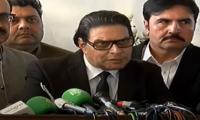PESHAWAR: The Supreme Court on Wednesday ordered formation of a judicial commission to probe December 16, 2014 carnage at the Army Public School (APS), Peshawar that left 147 people, including 122 students, dead.
A two-member bench, headed by Chief Justice of Pakistan (CJP) Mian Saqib Nisar and Justice Mansoor Ali Khan, ordered the constitution of judicial commission.
The bench directed the Peshawar High Court Chief Justice Yahya Afridi to nominate a senior judge of the high court for the judicial commission. The apex court issued the order on the applications of mothers of the victims who have formed the APS Martyrs Forum.
The forum has been demanding formation of a judicial commission and putting pressure on the government to punish the attackers and the officials who failed to counter the attack.
The chief justice told the parents of martyrs that the judicial commission would submit report within two weeks.
The mothers thanked the chief justice and said they had been demanding the judicial commission for the last three and a half years, but to no avail.
The parents have been seeking answers by pointing out that a threat alert was issued in August 2014 about a possible attack on the educational institutions run by the Pakistan Army and whether steps were taken by the relevant quarters, including the federal government and Khyber Pakhtunkhwa government, to foil the attack.
The parents, including Fazal Khan and Ajun Khan, stated that the National Counter Terrorism Authority (Nacta), Islamabad, had on August 28, 2014 through a letter informed the provincial government and Fata additional chief secretary that the commander of Tehreek-i-Taliban Pakistan in collaboration with others had a plan to carry out terrorist activities against the APS and other educational institutions run by the Pakistan Army to kill children of soldiers to avenge the killing of their accomplices.
They stated in their applications that the families of the victims had been asking the respondents to inform them why the information of the attack was not communicated to them and what action had been taken after the attack to fix responsibility.
During hearing of the case, the chief justice directed a lawyer, Fazal Khan, to leave the courtroom when he said he had no trust in the high court judge as the first petition for judicial inquiry had been pending there for years.
“How dare you talked against my judge in the courtroom,” the chief justice told him.
To implement the order of the chief justice, the Rangers came forward to expel the lawyer from the courtroom by force.
The top judge noticed the Rangers personnel moving towards Fazal Khan and directed them not to touch him as it was a matter between him and the lawyer.
On February 8, the PHC had disposed of a writ petition filed by the parents seeking formation of a judicial commission to probe the APS attack with the observation that it was the government’s mandate to initiate such an inquiry.
In another case, the Supreme Court ordered both the military and civil authorities to clear all the obstacles, pickets and hurdles on the roads and footpaths in Peshawar city within 48 hours except a few (three or four) if these were deemed necessary for high security after consultation with the Inter Services Intelligence (ISI), Intelligence Bureau (IB) and civil authorities.
During the hearing, the chief Justice observed that it was strange that walls and hurdles were being erected on roads and footpaths.
“I want the roads and footpaths cleared of all hurdles and pickets. They should erect steel walls and pickets inside the walls of the buildings rather than closing roads for the public,” the chief justice told the Khyber Pakhtunkhwa Chief Secretary Azam Khan.
He pointed out that hurdles on roads had been removed in Punjab.
Muhammad Khursheed Khan, senior Supreme Court lawyer, had brought before the apex court the issue of military check posts and erecting of walls and hurdles on the roads in Peshawar.
The chief justice told him that a list had been submitted to the court stating that military check posts had been removed next to the Polo Ground and on the Bara Road, Khyber Road and University Road.
He said most citizens wanted the chief justice to order removal of a military check post in Gora Qabristan locality where they were faced humiliation during checking.
The bench also ordered a judicial inquiry in the utilisation of funds received from foreign donors and allocated by the government for the rehabilitation of the October 8, 2005 earthquake victims.
The chief justice ordered the judicial inquiry while hearing a suo motu notice case pertaining to alleged embezzlement of funds meant for victims by the Earthquake Reconstruction and Rehabilitation Authority (Erra).
The apex court had taken notice on an application of Shahzad Mehmood Qureshi of Mansehra inviting the attention of the court towards the plight of earthquake victims living in makeshift houses without water facility and proper educational arrangements for their children despite a lapse of 13 years.
The court ordered that a district sessions judge would start the inquiry. The court said it would first prepare the Terms of Reference (TORs) for the judicial inquiry with consultation of relevant officials.
It said the commission would submit its report within six weeks to the Supreme Court.
Interestingly, a three-member bench was dissolved at the SC Peshawar Registry when one of the judges, Justice Qazi Faez Isa raised question over the proceedings on reports under Article 184 (3) of Constitution submitted by the provincial government on the direction of the Human Rights Cell regarding hospitals waste.
Justice Faez Isa asked the KP Advocate General to tell if it was a suo moto notice case or based on the complaint of Human Rights Cell.
The judge questioned whether the Human Rights Cell had power to ask the government to submit report without the court’s directions.
After difference of opinion on the issue, the chief justice dissolved the bench and then formed a new two-member bench.
Video putatively shows that Bushra shifted from her vehicle to Gandapur’s placing her bag first and later herself
ECC directs Finance Division to furnish detailed report on Pension Scheme Amendment
Vawda says woman said she would march on D-Chowk but later ran away, while referring to Bushra Bibi
Establishment Division has issued official notifications of these postings and transfers
Minister says police was effectively held hostage by KP CM and Bushra Bibi during recent PTI’s protest
Maryam says she was really sorry for inconvenience suffered by people







